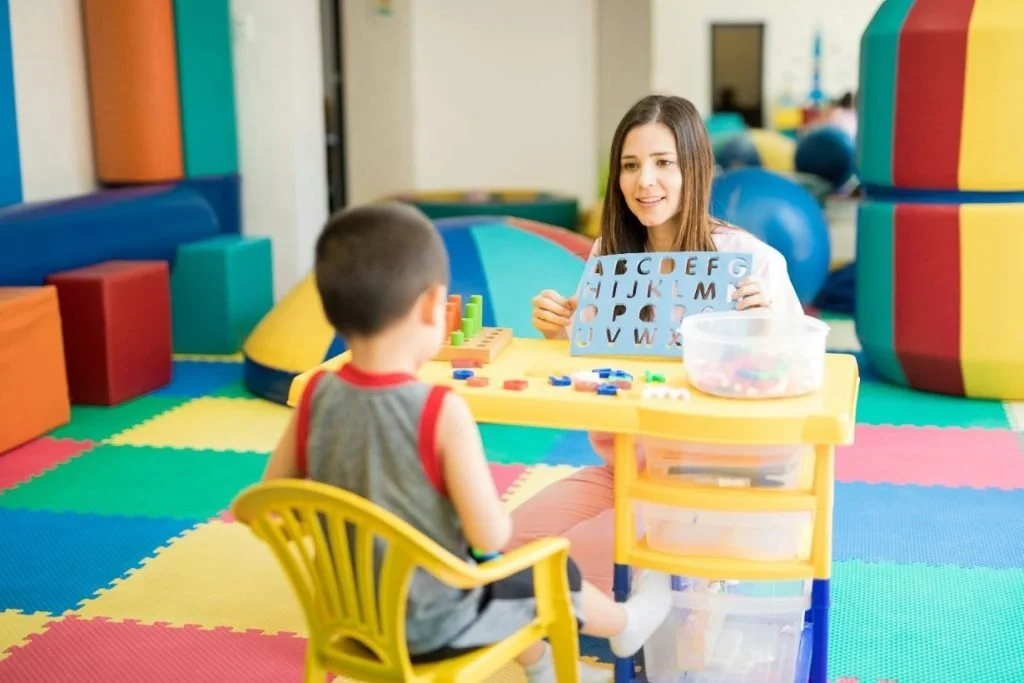Why Would A Child Need Occupational Therapy?
Paediatric occupational therapy (OT) is a crucial service that empowers children to develop essential daily living and learning skills. From fine motor abilities to social interactions, OT addresses various developmental needs. Understanding why a child might need occupational therapy, recognising common signs, and appreciating the importance of early intervention can significantly impact a child’s growth and independence.
What is Pediatric Occupational Therapy?
Paediatric occupational therapy focuses on enhancing a child’s ability to participate fully in daily activities at home, school, and the community. Paediatric occupational therapists work with children to develop physical, cognitive, motor and language skills and address emotional and sensory needs.
These professionals use a variety of techniques and interventions tailored to each child’s unique needs, helping them to:
Improve fine and gross motor skills
Enhance hand-eye coordination
Develop better sensory processing abilities
Learn self-care skills like dressing and eating
Improve social skills and peer interactions
Boost cognitive skills for better learning and problem-solving
By addressing these key areas, occupational therapy for children empowers young ones to overcome challenges, build independence, and thrive in their everyday lives.
The Importance of Early Intervention
Early intervention in occupational therapy is crucial for children experiencing developmental delays or challenges.
By addressing issues at a young age, therapists can:
Capitalise on the brain’s natural plasticity during early childhood
Prevent the development of compensatory behaviours that may hinder future progress
Build a strong foundation for future learning and development
Boost the child’s confidence and self-esteem
Reduce frustration and behavioural issues related to developmental challenges
Research shows early intervention improves outcomes for children with developmental, physical, or cognitive challenges. By identifying and addressing these issues early, occupational therapists can help set children on a path to greater independence, improved quality of life, and better overall development.
Why Children Need OT for Fine Motor Skills
Now that we’ve established the importance of early intervention, let’s explore the specific reasons why a child might need occupational therapy:
Developmental Delays: These can include delays in motor skills, cognitive skills, social-emotional skills, adaptive skills, developing skills, and sensory processing. Recognising these delays early is crucial for proper developmental assessments and interventions.
Sensory Processing Issues: Children with sensory processing issues may have difficulty responding to sensory input in a typical way. This can affect their ability to perform everyday tasks.
Fine Motor Skills: Difficulties with fine motor skills can impact a child’s ability to perform tasks such as writing, buttoning clothes, or using scissors.
Gross Motor Skills: Challenges with gross motor skills can affect a child’s ability to run, jump, or participate in sports and other physical activities.
Social Skills: Occupational therapy can help children develop the social skills necessary for interacting with peers and adults.
Self-Care Skills: These include tasks such as dressing, feeding, and personal hygiene. Children who struggle with self-care skills may benefit from occupational therapy to become more independent.
Occupational therapists help children with these challenges to reach their full potential in daily activities.
OT Needs in Children
While we’ve discussed common reasons for occupational therapy, it’s equally important for parents and caregivers to recognise the signs that indicate a child might benefit from these services.
Difficulty with Daily Self-Care Tasks: If your child struggles with age-appropriate activities like dressing, eating, grooming, or toileting, it may indicate delays in fine motor skills or sensory processing.
Fine Motor Skill Challenges: Poor handwriting, trouble using small tools, or difficulty manipulating objects like buttons or puzzle pieces can suggest underdeveloped fine motor control.
Poor Balance or Coordination: Frequent tripping, clumsiness, or difficulty catching a ball or navigating playground equipment may indicate gross motor skills or proprioception issues.
Sensory Sensitivities or Aversions: Over- or under-sensitivity to sensory input (like touch, sound, or light), sensory-seeking behaviours, or avoidance of certain textures in food or clothing could point to sensory processing disorders.
Social Interaction or Play Skill Issues: Trouble with turn-taking, understanding personal space, engaging in imaginative play, or following game rules might suggest challenges with social skills or cognitive development.
Focus and Attention Challenges: Being easily distracted, having difficulty sitting still for age- appropriate periods, or struggling with multi-step instructions could indicate attention issues or executive functioning difficulties.
Developmental Delays: If your child is not meeting expected milestones in areas such as physical, cognitive, or social-emotional development, occupational therapy can help address these delays.
Difficulties Related to Specific Conditions: Children with diagnoses such as Autism Spectrum Disorder (ASD), Attention Deficit Hyperactivity Disorder (ADHD), or learning disabilities often benefit from occupational therapy to address associated challenges.
Consider consulting an occupational therapist if you notice several of these signs in your child. Early intervention can significantly improve outcomes and support your child’s development across various domains of daily life. Having identified some of these signs in your child, you might wonder about the next steps.
Let’s now walk through the typical process of paediatric occupational therapy.
Occupational Therapy: What to Expect
Pediatric occupational therapists are crucial in helping children overcome challenges and develop essential skills. Paediatric occupational therapy is structured to help children overcome challenges and develop essential skills.
The therapy journey typically includes the following steps:
Initial Assessment
Information gathering about the child’s medical history and current challenges
Observation of the child’s behaviour and abilities
Conducting standardised tests
Evaluation helps the therapist understand the child’s current abilities and challenges
Goal Setting
Collaborative process involving the therapist, child, and parents
Ensures therapy aligns with family priorities and the child’s specific needs
Treatment Plan Development
Creation of a customised plan including exercises, activities, and modifications
Designed to help the child progress towards established goals
Therapy Sessions
Individual sessions: One-on-one work on specific skills
Group sessions: Opportunities for peer interaction and social skills practice
Activities may include:
Fine and gross motor exercises
Sensory integration activities
Self-care practice
Cognitive and social skill development
Progress Monitoring
Regular reassessments to ensure therapy meets the child’s evolving needs
Adjustments to the treatment plan as necessary
Home Program
Activities for practice at home
Parent education to ensure continuity of care beyond therapy sessions
Follow-up and Discharge
Ongoing evaluation as the child progresses
Gradual reduction in therapy intensity
Discharge planning to ensure the child maintains progress
Throughout this journey, continuous communication is maintained between the therapist, child, family, and other professionals, ensuring a holistic approach to the child’s development.
Having explored the various aspects of paediatric occupational therapy, from its importance to the therapy process itself, let’s summarise the key takeaways.
Conclusion
Occupational therapy offers vital support for children with developmental challenges, helping them acquire essential skills and overcome daily obstacles. Parents can make informed care decisions by recognising when this therapy might benefit their child. Through tailored interventions, occupational therapy equips children with the tools for success in various life areas, addressing immediate needs while building a foundation for future independence and confidence.
Frequently Asked Questions
What is paediatric occupational therapy?
Pediatric occupational therapy helps children develop the skills for daily activities and learning. It focuses on improving fine motor skills, sensory processing, self-care, and social skills.
Why is it called “occupational” therapy for children?
A child’s “occupations” are the everyday activities that occupy their time, such as playing, learning, and self-care tasks. Occupational therapy helps children perform these age-appropriate activities more effectively.
What signs indicate my child might need occupational therapy?
Common signs include:
Difficulty with daily self-care tasks (dressing, eating, grooming)
Struggles with handwriting or using scissors
Poor balance or coordination
Sensory sensitivities or aversions
Difficulty with social interactions or play skills
Challenges with focus and attention in school
What happens during an occupational therapy evaluation?
An evaluation typically includes:
Discussion of medical history and concerns
Standardised tests to assess skills
Observation of the child’s abilities
Development of a treatment plan if therapy is recommended
How long does occupational therapy typically last?
The duration varies for each child. Your therapist will provide an estimate based on your child’s specific needs and progress.
How can I support my child’s occupational therapy at home?
Regularly attend scheduled appointments
Follow through with home exercise programs provided by the therapist
Communicate openly with the therapist about concerns and progress
Incorporate recommended activities into your daily routine
Does insurance cover occupational therapy?
Many insurance plans cover occupational therapy, but coverage varies. It’s best to check with your insurance provider about your specific plan.
Is occupational therapy just for children with disabilities?
No, occupational therapy can benefit children with various challenges, including developmental delays, sensory processing issues, and difficulties with fine motor skills or self-care tasks.



